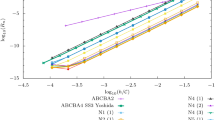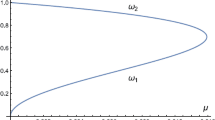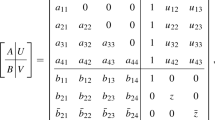Abstract
We construct an explicit reversible symplectic integrator for the planar 3-body problem with zero angular momentum. We start with a Hamiltonian of the planar 3-body problem that is globally regularised and fully symmetry reduced. This Hamiltonian is a sum of 10 polynomials each of which can be integrated exactly, and hence a symplectic integrator is constructed. The performance of the integrator is examined with three numerical examples: The figure eight, the Pythagorean orbit, and a periodic collision orbit.









Similar content being viewed by others
References
Blanes, S.: Symplectic maps for approximating polynomial Hamiltonian systems. Phys. Rev. E. Stat. Nonlinear Soft. Matter Phys. 65(5 Pt 2), 056,703 (2002)
Blanes, S., Budd, C.J.: Adaptive geometric integrators for Hamiltonian problems with approximate scale invariance. SIAM J. Sci. Comput. 26, 1089–1113 (2005)
Blanes, S., Iserles, A.: Explicit adaptive symplectic integrators for solving hamiltonian systems. Celest. Mech. Dyn. Astron. 114, 297–317 (2012)
Channell, P. J., Neri, F. R.: An Introduction to Symplectic Integrators, vol. 10. Fields Institute, Communications, pp. 45–58. American Mathematical Society (1996)
Chenciner, A., Montgomery, R.: A remarkable periodic solution of the three body problem in the case of equal masses. Ann. Math. 152, 881–901 (2000)
Gjaja, I.: Monomial factorization of symplectic maps. Part. Accel. 43(3), 133–144 (1994)
Gruntz, D., Waldvogel, J.: Orbits in the planar three-body problem. In: Gander, W., Hřebíček, J. (eds.) Solving Problems in Scientific Computing Using Maple and Matlab, Chap. 4, 4th edn, pp. 51–72. Springer, Berlin (2004)
Hairer, E., Lubich, C., Wanner, G.: Geometric Numerical Integration. Springer, Berlin (2002)
Heggie, D.: A global regularisation of the gravitationaln-body problem. Celest. Mech. 10(2), 217–241 (1974)
Ito, T., Tanikawa, K.: Trends in 20th century celestial mechanics. Publ. Natl. Astron. Obs. Jpn. 9, 55–112 (2007)
Kustaanheimo, P., Stiefel, E.: Perturbation theory of kepler motion based on spinor regularization. J. Math. Bd. 218, 27 (1965)
Leimkuhler, B., Reich, S.: Simulating Hamiltonian Dynamics. Cambridge University Press, Cambridge (2004)
Lemaître C (1964) The three body problem. Technical report, NASA CR-110. http://ntrs.nasa.gov/
McLachlan, R.I., Quispel, G.R.W.: Splitting methods. Acta Numer. 11, 341–434 (2002)
Mikkola, S.: Practical symplectic methods with time transformation for the few-body problem. Celest. Mech. Dyn. Astron. 67, 145–165 (1997)
Moeckel, R., Montgomery, R.: Symmetric regularization, reduction and blow-up of the planar three-body problem (2012, preprint). arXiv:12020972
Moore, C.: Braids in classical dynamics. Phys. Rev. Lett. 70, 3675–3679 (1993)
Preto, M., Tremaine, S.: A class of symplectic integrators with adaptive time step for separable hamiltonian systems. Astron. J. 118, 2532–2541 (1999)
Quispel, G.R.W., Mclachlan, R.: Explicit geometric integration of polynomial vector fields. BIT Numer. Math. 44, 515–538 (2004)
Shi, J., Yan, Y.T.: Explicitly integrable polynomial hamiltonians and evaluation of lie transformations. Phys. Rev. E 48(5), 3943 (1993)
Simó, C.: Periodic orbits of the planar N-body problem with equal masses and all bodies on the same path. In: Steves, B.A., Maciejewski, A.J. (eds.) pp. 265–284. The Restless Universe (2001)
Simó, C.: Dynamical properties of the figure eight solution of the three-body problem. In: Chenciner, A., Cushman, R., Robinson, C., Xia, Z.J. (eds.) Celestial Mechanics, Dedicated to Donald Saari for his 60th Birthday, Vol. 1, pp. 209–228 (2002)
Szebehely, V., Peters, C.F.: Complete solution of a general problem of three bodies. Astron. J. 72, 876–883 (1967). doi:10.1086/110355
Waldvogel, J.: A new regularization of the planar problem of three bodies. Celest. Mech. 6, 221–231 (1972). doi:10.1007/BF01227784
Waldvogel, J.: Symmetric and regularized coordinates on the plane triple collision manifold. Celest. Mech. 28, 69–82 (1982)
Yoshida, H.: Construction of higher order symplectic integrators. Phys. Lett. A 150, 262–268 (1990)
Author information
Authors and Affiliations
Corresponding author
Appendix: Integrator stages
Appendix: Integrator stages
Section 3.1 described how to integrate a monomial Hamiltonian, and Sect. 3.2 described the splitting of Eq. (2) into a minimal number of solvable parts and those solutions. Here we use those solutions to build an explicit first order symplectic composition method for (2).
Let the timestep be \(\varDelta \tau \), let \(\mu _j = (m_k + m_l)\), let the values of the system before and after one timestep respectively be \(\varvec{z}_0 = (\alpha _{1,0},\dots ,\pi _{3,0})^T\) and \(\varvec{z}_1 = (\alpha _{1,1},\ldots ,\pi _{3,1})^T\) and intermediate steps be \(\varvec{\xi }_i = (\alpha _{1,.i-1},\ldots ,\pi _{3,.i-1})^T\). Now
Rights and permissions
About this article
Cite this article
Rose, D., Dullin, H.R. A symplectic integrator for the symmetry reduced and regularised planar 3-body problem with vanishing angular momentum. Celest Mech Dyn Astr 117, 169–185 (2013). https://doi.org/10.1007/s10569-013-9503-x
Received:
Revised:
Accepted:
Published:
Issue Date:
DOI: https://doi.org/10.1007/s10569-013-9503-x




